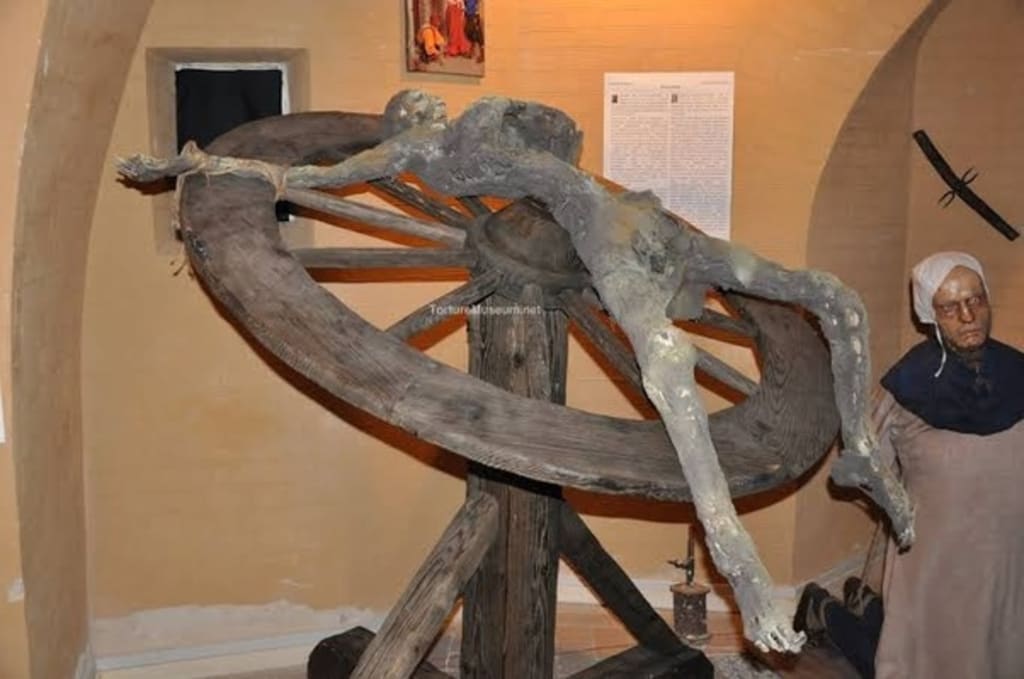Content warning
This story may contain sensitive material or discuss topics that some readers may find distressing. Reader discretion is advised. The views and opinions expressed in this story are those of the author and do not necessarily reflect the official policy or position of Vocal.
The Breaking Wheel: A Gruesome Instrument of Medieval Justice
Gruesome Torture

Throughout history, societies have devised various methods of punishment and execution, often designed to inflict maximum pain and public humiliation. Among these, the breaking wheel, also known as the execution wheel, the Wheel of Catherine, or simply the Wheel, stands out as one of the most brutal and effective means of public execution. Used primarily in Europe from antiquity through the Middle Ages and into the early modern period, the breaking wheel was a gruesome tool for meting out justice by breaking the bones of a criminal or bludgeoning them to death. This blog post explores the historical context, procedure, and cultural significance of the breaking wheel, shedding light on its role in European punitive practices.
Historical Context and Origins
The breaking wheel's origins can be traced back to antiquity, where variations of this execution method were employed by ancient civilizations, including the Greeks and Romans. However, it became particularly notorious in medieval Europe, where it was used extensively as a form of capital punishment. The breaking wheel was often reserved for severe crimes, such as murder, robbery, and treason, reflecting its function as a tool of extreme retribution and public spectacle.
The practice reached its peak during the Middle Ages and continued into the early modern period. The breaking wheel's use was documented in various European countries, including France, Germany, and the Netherlands, each adapting the method to their legal and cultural contexts. The wheel was not merely a tool for execution; it was a symbol of state power and judicial authority, reinforcing societal norms and deterring criminal behavior through its sheer brutality.
The Procedure of the Breaking Wheel
The procedure of the breaking wheel varied across regions and periods, but the fundamental principles remained consistent. The execution began with the condemned criminal being publicly paraded to the execution site, often a central square or prominent location, to maximize the spectacle's visibility and impact.
At the site, the criminal was typically tied to a large wooden wheel. This wheel could either be placed horizontally on a scaffold or vertically on a stand, depending on the local customs. The condemned was bound to the wheel with their limbs spread out, exposing their body to the executioner's blows.
The executioner, wielding a heavy iron bar or hammer, would then proceed to methodically break the bones of the criminal. The limbs—arms and legs—were the primary targets, with the executioner delivering crushing blows designed to shatter the bones without causing immediate death. The intent was to inflict prolonged agony and disable the victim, making it impossible for them to move.
In some variations, the breaking wheel involved a pre-mortem phase where the criminal was positioned under the wheel, which was then turned, crushing the limbs against a wooden frame beneath it. This method added an additional layer of torment and visual horror.
After the limbs were broken, the executioner might deliver a final, fatal blow to the chest or head, or, in some cases, leave the criminal to die from their injuries over time. The broken body was often left on display, either still bound to the wheel or placed on a pole, as a grim reminder to the populace of the consequences of criminal behavior.
Cultural and Symbolic Significance
The breaking wheel was not merely an instrument of execution; it held significant cultural and symbolic meaning. It served as a powerful deterrent, reinforcing the authority of the state and the seriousness of the crimes it punished. The public nature of the executions was intended to instill fear and demonstrate the consequences of defying societal laws and norms.
The breaking wheel also carried religious connotations. Saint Catherine of Alexandria, a Christian martyr, was famously associated with the wheel after reportedly being sentenced to be broken on it for her faith. According to legend, the wheel shattered upon her touch, leading to her execution by beheading instead. This association led to the wheel being known as the Wheel of Catherine, further embedding it in the cultural and religious consciousness of medieval Europe.
The Decline of the Breaking Wheel
As Europe transitioned into the modern era, the use of the breaking wheel began to decline. Enlightenment ideals and evolving legal philosophies brought about a shift in attitudes towards punishment and justice. The emphasis moved from public spectacle and physical torment to more humane and regulated forms of punishment. The breaking wheel, with its extreme brutality, became increasingly seen as barbaric and incompatible with emerging concepts of human rights and dignity.
By the 18th and 19th centuries, the breaking wheel had largely fallen out of use, replaced by more standardized methods of execution such as hanging, beheading, and eventually the guillotine. The last known use of the breaking wheel occurred in the early 19th century, marking the end of its gruesome chapter in European punitive history.
Reflections on Human Cruelty and Justice
The breaking wheel serves as a stark reminder of the lengths to which societies have gone in the name of justice and deterrence. Its brutality highlights the darker aspects of human nature and the historical context in which such practices were deemed necessary or justified. Reflecting on the use of the breaking wheel allows us to appreciate the progress made in the fields of law and human rights, emphasizing the importance of continued efforts to ensure justice is administered with humanity and respect for individual dignity.
Conclusion
The breaking wheel stands out as one of history's most brutal methods of public execution, symbolizing the harsh realities of medieval justice. From its origins in antiquity to its decline in the modern era, the wheel's use highlights the evolving nature of societal attitudes towards punishment and the administration of justice. While it serves as a grim reminder of human cruelty, it also underscores the importance of humane and equitable treatment within legal systems. Understanding the history of the breaking wheel helps us appreciate the strides made in human rights and the ongoing need to balance justice with compassion.
About the Creator
Enjoyed the story? Support the Creator.
Subscribe for free to receive all their stories in your feed. You could also pledge your support or give them a one-off tip, letting them know you appreciate their work.






Comments
There are no comments for this story
Be the first to respond and start the conversation.